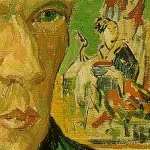
I've blogged before about struggling with those nusiance details of history, hoping to avoid anachronisms that are bound to set certain readers off. I'm not really complaining. It's part of the duty--and the pleasure, really--of being a writer of historical fiction, who in his best incarnation is both radically imaginative and someting of a wonk.
Anyway, another of the details I've debated over while drafting my book is the matchstick. During early drafts of the novel, when I needed Vincent or another character to light something, I did so vaguely, with indefinite references to "flint," assuming for some reason that matches didn't exist in the 1850s to 1880s. With everything else I was juggling with as I composed the book I decided not to worry about it right away, but over time and a little research I came to realize that some form of matchstick probably did exist in Van Gogh's time. So I went ahead and just had him light a match when necessary. Simple, direct. Everybody gets it. What this match looked like I wasn't sure and had to leave it for the reader to decide (normally bad writing advice), but I assumed it would be something akin to those thin wooden sticks, a couple of inches long, that you find sold in rectangular cardboard boxes in drug stores and grocery stores, rather than the paper "matchbook" match, which was what everyone used when I was growing up in the 70s--when smoking was more widespread and every bar and restaurant in America gave away matchbooks as advertising. (In my house, there was always a matchbook around, probably within a few feet of wherever you were.) In addition to not really being sure what these matches looked like, I still wasn't 100% sure that what I think of as a match is what I could really count on as being contemporary with the second half of the 19th century. Until recently, the best confirmation I got was a reference to "lucifers" in Peter Carey's historical novel True History of the Kelly Gang. That seemed confirmation enough, although questions still dangled in the back of my mind that I knew I needed to answer sooner or later, once and for all. Just as soon as I solved a million other mysteries.
What a thrill then that, while watching a recent episode of Mythbusters, a little factoid came up telling me that the first friction match was invented by Englishman John Walker in the 1826! Eureka! Thank you, Adam and Jamie! Another nagging question put to bed. If you've see the Mythbusters on the Discovery Channel--and who in America hasn't at this point--you know how entertaining it is to see the gang on that show test commonly held notions about products and situations and even species. Great to know that Mythbusters is also a resource for novelists.













0 comments:
Post a Comment